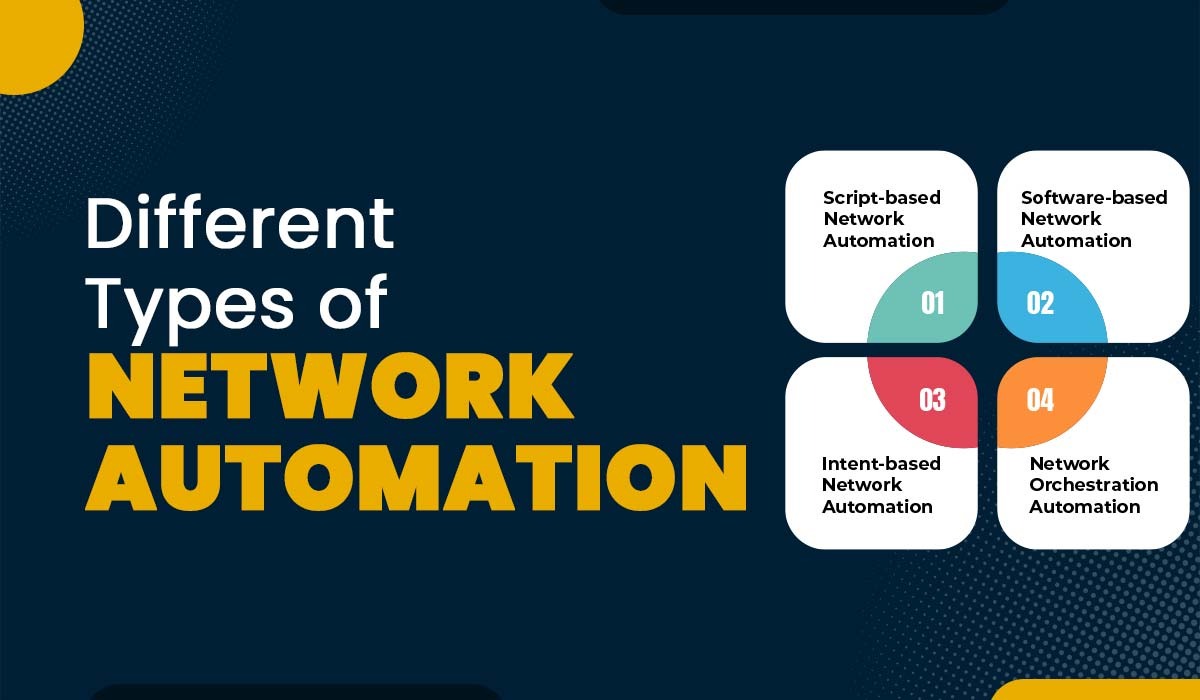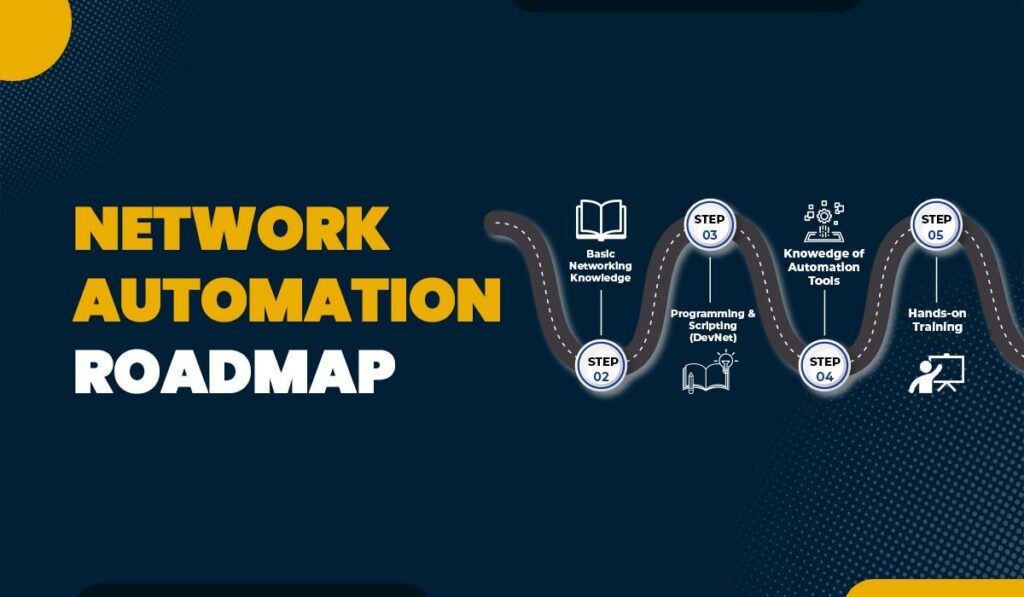Introduction
Automation has transformed the way we work, live, and interact with technology. From manufacturing to healthcare, automation has streamlined processes, reduced human error, and improved efficiency. In the field of networking, automation has become crucial for modern infrastructure management. With the increasing complexity of networks, manual configuration and management have become impractical, giving rise to various types of network automation. Our Network Automation Course equips you with the skills to automate, optimize, and manage modern network infrastructures efficiently.
In this blog, we will explore the different network automation types, their significance, and how they are transforming network management, but let us first understand what network automation is.
What is Network Automation?
Network automation is defined as the act of dealing with networks wherein most tasks are conducted in auto mode without involving human interaction. It is done via the usage of tools, software, and scripts that will automate processes involving the configuration of devices, monitoring of network performance, or troubleshooting.
For instance, a network administrator will have to do the same job manually if they wish to put the same settings on several routers. Accessing the routers personally and manually entering the configurations would be challenging and time-consuming without the assistance of automation. By means of network automation, the same configuration can be copied concurrently in every router by the administrator using a script or a software tool, therefore replicating the settings to all the routers in a short period and free of mistakes.
In other words, network automation is a way to ease the work of network engineers by automating all those tasks that do not demand much attention in detail.
Types of Network Automation
There are mainly four types of network automation, these are:
- Script-based network automation
- Software-based network automation
- Intent-based network automation
- Network orchestration automation
Every type has particular benefits and application areas. Let’s discuss each one individually.
1. Script-Based Network Automation
Among the first and easiest types of network automation is script-based network automation. It involves developing scripts to handle particular tasks on network devices. Scripts are normally developed in scripting languages like Python, Perl, Bash, or Power Shell and intended to run the network device using protocols like SSH & telnet.
How It Works?
In Scripting-based management, a network administrator creates a script that they need to perform a certain activity like configuring a router, gathering device details, checking the state of its network, and so on. It is then running over a server or workstation against the network devices to accomplish the task.
Example
Imagine you have 50 switches in your network, and you need to enable a specific feature on all of them. Instead of logging into each switch and enabling the feature manually, you can write a script that connects to each switch, sends the necessary commands, and logs the results. This saves time and reduces the likelihood of errors.
Advantages of Script-based Network Automation
Some of the advantages of using script-based network automation are:
- Cost-Effective: This is a cost-friendly approach since it involves the use of Script and its resources which are mostly free.
- Flexibility: They are easily adaptable to a particular task because they are easily written and can be modified as needed.
- Ease of use: It is easy to write and run scripts, especially in small works and small networks.
Disadvantages of Script-based Network Automation
Apart from the advantages the script-based network automation offers, it also has some disadvantages. These are:
- Lack of scalability: It becomes very difficult to scale Scripts with the rising network’s size.
- Error-Prone: One disadvantage of a script is that if there is an error in the script, it may result in a problem on any device.
- Requires Technical Skills: Script-based automation demands the understanding of at least scripting languages and network devices.
Network automation using script-based is suitable in simple networks or for specific task purposes only, but it may not be suitable for large networks and also other various complex workflows.
2. Software-Based Network Automation
Software-based network automation is the second automation method in which the actual project is completed through the usage of specialized tools. They are better than scripts for automation as they give a more comprehensive and flexible solution.
How It Works?
Ansible, Chef, or Puppet are examples of software-based network automation tools that utilize a declarative model. Rather than providing scripts, the administrators set a goal and describe how the network should be configured, and the software adjusts the system accordingly.
These tools directly interact with the network devices by using APIs and most of them are capable of performing various activities such as configuration management, enforcing policies, and even monitoring.
Example
Now let’s assume you want to ensure that firewalls in the network have an equal set and type of security enforcement. With software-based automated tools, the policy can be set once for all the firewalls. The tool will scan each firewall in the group, compare the current configuration then update it with the configuration specified in the model, and thereafter make some changes.
Advantages
Some of the advantages of software-based network automation are:
- Scalability: With the help of software-based network automation, it becomes easier to implement large and complex networks.
- Consistency: One of the major benefits of using software-based network automation is that by defining the preferred state of the network, the network engineers can achieve consistency in all devices.
- Integration: These tools must be integrated with other systems like the orchestration platforms to make these powerful methods efficient.
- Reduce human error: This reduces the chances of making errors since the tools can execute tasks with less variation than what an individual can do.
Disadvantages
There are some disadvantages to using software-based network automation. These are:
- Complexity: It is difficult for a newcomer to effectively set up as well as configure software-based automation tools.
- Cost: Some of the network automation tools do come with a cost since they are licensed, resulting in high total costs.
- Learning curve: The administrators may require learning new skills in order to be in a position to manage these automation tools.
The application of software-based network automation is advisable for mid to large networks when it comes to scalability and centralized network management. This tool offers optimal solutions for the management of large-scale organizations.
3. Intent-Based Network Automation
Next in the list of types of network automation is Intent-based network automation, which is a relatively new concept that goes beyond traditional network automation that mainly focuses on specific commands or configurations. Its sole purpose is to focus on the desired outcome of the network operations. It hides the complexity of networks and allows the admin to set goals in simple blocks.
How It Works?
Intent-based automation tools implement the intent of the network through instruction written in a high-level language or by adding a graphical interface. It then translates the above intent to the appropriate low-level instructions and configurations across the network. This makes it possible for the administrators to focus more on what they expect the network to deliver in achieving its objectives and not how it could be done.
They usually make use of machine learning as well as other artificial intelligence technologies to read through traffic for possible issues, and promptly adjust the course for the best possible network performance.
Example
Suppose you wish to provide a specific priority to the traffic belonging to a video conferencing application in your network. With intent-based network automation, you can just tell the system that video traffic has the highest priority. It will then be able to proceed to configure settings like Quality of Service (QoS) depending on the type of traffic being passed through the network, in this case, video traffic.
Advantages
Some of the advantages of intent-based network automation are:
- Simplicity: Intent-based automation means that you do not have to think about how to implement or necessarily even understand how it is done.
- Scalability: These tools can modify their characteristics to accommodate the changing condition of the network.
- Simplified Work: Since it hides the network details as well as its complexity, intent-based automation allows even those people who are not closely connected with the field to work on it.
- Better Security: With intent-based automation, there is always a strong security measure to implement where possible risks are seen.
Disadvantages
There are some disadvantages to using intent-based network automation, these are:
- Challenges of the Implementation: The process of implementing intent-based automation is complex due to the need for both tools and training.
- Lack of Flexibility: Due to the software’s ability to self-configure, there may be less control over certain aspects by the admin.
- Reliance on artificial intelligence and machine learning: The ideal model for intent-based automation is based on artificial intelligence and machine learning which require further enhancement of models used in the methods.
Intent-based network automation is becoming preferred in large and dynamic networks because it is flexible and straightforward. It is the future of network automation, and more enterprises are adopting it.
4. Network Orchestration Automation
The last among the types of Network Automation is Network orchestration automation, which is the most advanced form of automated networks, defined as the multi-level linking of several automation tools in the management of networks. It is the master control center of the networks and makes sure that all forms of automation work in an integrated and coordinated way.
How It Works?
Network orchestrations, for example, Cisco NSO (Network Service Orchestrator), and Juniper’s Contrail are available to manage several automation tasks through a single console. Several of these tools interact with other tools, scripts, and APIs as a network of tools used in managing networks.
Network orchestration tools also leverage Workflows in order to define complex automation processes, for instance, provisioning a new network service, scaling infrastructure, or responding to network events.
Example
You have planned to establish a new branch for your organization and you are required to provide all the network services at this branch. With the help of network orchestration automation, you allocate the resources and schedule the provisions of the necessary hardware, configuring network devices and security policies and connectivity on their own. Particularly, the orchestration tool would manage all the steps required for ordering the hardware and configuring the network, among others, making the process smooth.
Advantages
Some of the advantages of Network orchestration automation are:
- Comprehensive Management: Orchestration tools enable users to manage all the processes involved in the network automation from a single place or point.
- Effectiveness: Automation of a process through process orchestration means that it would take a shorter amount of time, energy, and other resources to complete when compared to traditional methods.
- Scalability: Orchestration automation is built to handle large and complex networks; thus, it highly applies to enterprise organizations.
- Integration: With the help of integration, these tools can be integrated with the various automation tools and systems, thus forming a single network management environment.
Disadvantages
Some of the disadvantages of Network orchestration automation are:
- Complexity and Cost: Challenges of Network orchestration automation include cost and level of complexity, including tools, infrastructure, and training.
- Dependency on Integration: A major factor that determines the result of orchestration tools is the dependency it has on other tools.
- Learning Curve of Orchestration Tools: Orchestration tools are a little hard to handle due to their complexity and need for high technical expertise.
Network orchestration automation is most appropriate for large companies with extensive networks, which must be managed effectively and efficiently.
These are the 4 types of Network Automation.
Frequently Asked Questions
Q1. What are the 4 types of automation?
Four types of network automation are:
- Script-based network automation
- Software-based network automation
- Intent-based network automation
- Network orchestration automation
Q2. What is an automation network?
Network automation is a process of automating tasks which include managing and configuring network devices, and reducing manual tasks and errors.
Q3. What are the three basic types of automation?
The three basic types of automation are:
- Fixed
- Programmable
- Flexible
Q4. What are the different types of network traffic?
Different types of network traffic are packet type, packet flow, transmission protocol, QoS priority, transmission method, and source.
Conclusion
Network automation is an important concept, as it allows you to manage the network by improving the efficiency as well as the consistency of operations. There are four types of network automation to fit organizations’ needs, script-based for small networks, software-based for medium networks, centralized intent-based for dynamic and large, and orchestration for coverage of all the mentioned. In this blog, we have explained different network automation types along with their functions, examples, advantages, and disadvantages.





